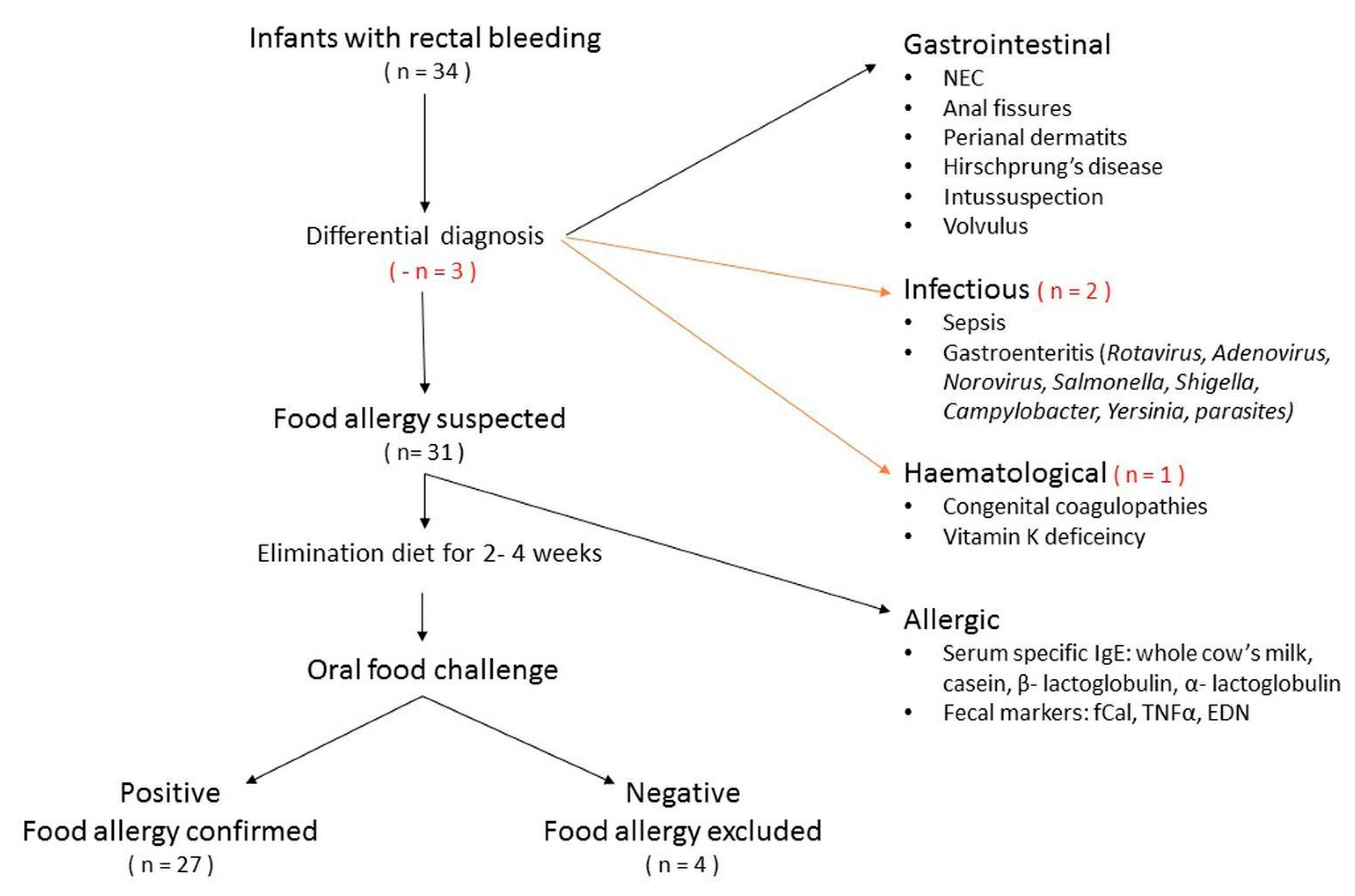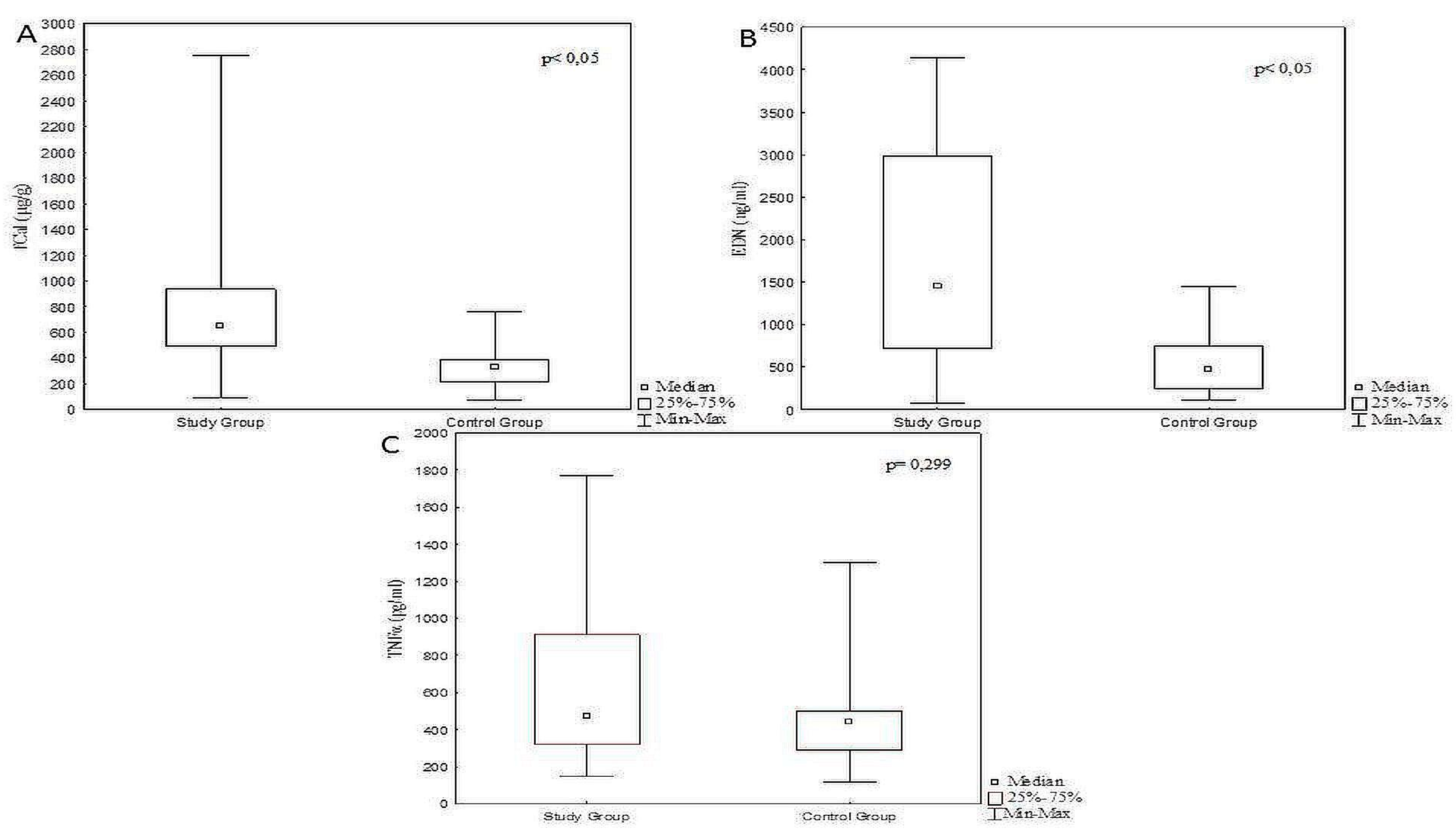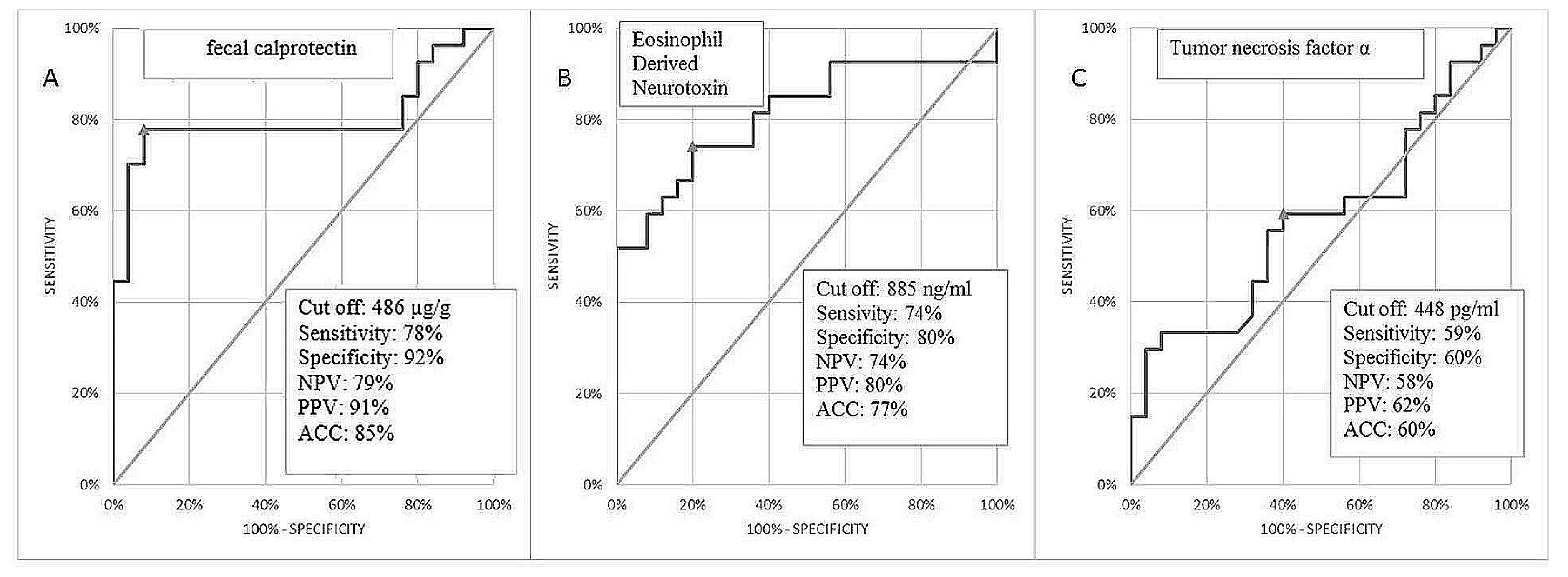Eosinophil-Derived Neurotoxin, Tumor Necrosis Factor Alpha, and Calprotectin as Non-Invasive Biomarkers of Food Protein-Induced Allergic Proctocolitis in Infants
Abstract
1. Introduction
2. Materials and Methods
2.1. Patients and Study Design
2.2. Serum-Specific IgE Measurement
2.3. Open Oral Food Challenge
2.4. Fecal Markers Measurement
2.5. Statistical Analysis
3. Results
4. Discussion
Author Contributions
Funding
Acknowledgments
Conflicts of Interest
References
- Johansson, S.G.O.; Bieber, T.; Dahl, R.; Friedmanm, P.S.; Lanier, B.; Lockey, R.; Motala, C.; Ortega Martel, J.A.; Platts-Mills, T.A.E.; Ring, J.; et al. Revised nomenclature for allergy for global use: Report of the Nomenclature Review Committee of the World Allergy Organization, October 2003. J. Allergy Clin. Immunol. 2004, 113, 832–836. [Google Scholar] [CrossRef] [PubMed]
- Soares-Weiser, K.; Takwoingi, Y.; Panesar, S.S.; Muraro, A.; Werfel, T.; Hoffmann-Sommergruber, K.; Roberts, G.; Halken, S.; Poulsen, L.; van Ree, R.; et al. The diagnosis of food allergy: A systematic review and meta-analysis. Allergy 2014, 69, 76–86. [Google Scholar] [CrossRef] [PubMed]
- Daniluk, U.; Alifier, M.; Kaczmarski, M.; Stasiak-Barmuta, A.; Lebensztejn, D. Longitudinal observation of children with enhanced total serum IgE. Ann. Allergy Asthma Immunol. 2015, 114, 404–410. [Google Scholar] [CrossRef] [PubMed]
- Nowak-Węgrzyn, A. Food protein-induced enterocolitis syndrome and allergic proctocolitis. Allergy Asthma Proc. 2015, 36, 172–184. [Google Scholar] [CrossRef]
- Arvola, T.; Ruuska, T.; Keränen, J.; Hyöty, H.; Salminen, S.; Isolauri, E. Rectal bleeding in infancy: Clinical, allergological, and microbiological examination. Pediatrics 2006, 117, 760–768. [Google Scholar] [CrossRef]
- Xanthakos, S.A.; Schwimmer, J.B.; Melin-Aldana, H.; Rothenberg, M.E.; Witte, D.P.; Cohen, M.B. Prevalence and outcome of allergic colitis in healthy infants with rectal bleeding: A prospective cohort study. J. Pediatr. Gastroenterol. Nutr. 2005, 41, 16–22. [Google Scholar] [CrossRef]
- Koletzko, S.; Niggemann, B.; Arato, A.; Dias, J.A.; Heuschkel, R.; Husby, S.; Mearin, M.L.; Papadopoulou, A.; Ruemmele, F.M.; Staiano, A.; et al. Diagnostic approach and management of cow’s-milk protein allergy in infants and children: ESPGHAN GI Committee practical guidelines. J. Pediatr. Gastroenterol. Nutr. 2012, 55, 221–229. [Google Scholar] [CrossRef]
- Yum, H.Y.; Yang, H.J.; Kim, K.W. Oral food challenges in children. Korean J. Pediatr. 2011, 54, 6–10. [Google Scholar] [CrossRef]
- Sicherer, S.H.; Sampson, H.A. Food allergy: A review and update on epidemiology, pathogenesis, diagnosis, prevention, and management. J. Allergy Clin. Immunol. 2018, 141, 41–58. [Google Scholar] [CrossRef]
- Filimoniuk, A.; Daniluk, U.; Samczuk, P.; Wasilewska, N.; Jakimiec, P.; Kucharska, M.; Lebensztejn, D.M.; Ciborowski, M. Metabolomic profiling in children with inflammatory bowel disease. Adv. Med. Sci. 2020, 65, 65–70. [Google Scholar] [CrossRef]
- Daniluk, U.; Daniluk, J.; Krasnodebska, M.; Lotowska, J.M.; Sobaniec-Lotowska, M.E.; Lebensztejn, D.M. The combination of fecal calprotectin with ESR, CRP and albumin discriminates more accurately children with Crohn’s disease. Adv. Med. Sci. 2019, 64, 9–14. [Google Scholar] [CrossRef] [PubMed]
- Wada, T.; Toma, T.; Muraoka, M.; Matsuda, Y.; Yachie, A. Elevation of fecal eosinophil-derived neurotoxin in infants with food protein-induced enterocolitis syndrome. Pediatr. Allergy Immunol. 2014, 25, 617–619. [Google Scholar] [CrossRef] [PubMed]
- Morita, H.; Nomura, I.; Shoda, T. Fecal Eosinophil-derived neurotoxin is significantly elevated in non- IgE dependent Gastrointestinal allergies, especially in subtypes showing bloody stool [abstract]. J. Allergy Clin. Immunol. 2012, 129, A353. [Google Scholar]
- Wada, H.; Horisawa, T.; Inoue, M.; Yoshida, T.; Toma, T.; Yachie, A. Sequential measurement of fecal parameters in a case of non-immunoglobulin E-mediated milk allergy. Pediatr. Int. 2007, 49, 109–111. [Google Scholar]
- Kapel, N.; Roman, C.; Caldari, D. Fecal tumor necrosis factor-alpha and calprotectin as differential diagnostic markers for severe diarrhea of small infants. J. Pediatr. Gastroenterol. Nutr. 2005, 41, 396–400. [Google Scholar] [CrossRef]
- Kalach, N.; Kapel, N.; Waligora-Dupriet, A.J.; Castelain, M.C.; Cousin, M.O.; Sauvage, C.; Ba, F.; Nicolis, I.; Campeotto, F.; Butel, M.J.; et al. Intestinal permeability and fecal eosinophil-derived neurotoxin are the best diagnosis tools for digestive non-IgE-mediated cow’s milk allergy in toddlers. Clin. Chem. Lab. Med. 2013, 51, 351–361. [Google Scholar] [CrossRef]
- Yanagida, N.; Minoura, T.; Kitaoka, S.; Ebisawa, M. A three-level stepwise oral food challenge for egg, milk, and wheat allergy. J Allergy Clin. Immunol. Pract. 2018, 6, 658–660. [Google Scholar] [CrossRef]
- Nowak-Wegrzyn, A.; Berin, M.C.; Mehr, S. Food Protein-Induced Enterocolitis Syndrome. J. Allergy Clin. Immunol. Pract. 2020, 8, 24–35. [Google Scholar] [CrossRef]
- Nowak-Węgrzyn, A.; Chehade, M.; Groetch, M.E.; Spergel, J.M.; Wood, R.A.; Allen, K.; Atkins, D.; Bahna, S.; Barad, A.V.; Berin, C.; et al. International consensus guidelines for the diagnosis and management of food protein-induced enterocolitis syndrome: Executive summary-Workgroup Report of the Adverse Reactions to Foods Committee, American Academy of Allergy, Asthma & Immunology. J. Allergy Clin. Immunol. 2017, 139, 1111–1126.e4. [Google Scholar] [CrossRef]
- Summerton, C.B.; Longlands, M.G.; Wiener, K.; Shreeve, D.R. Faecal calprotectin: A marker of inflammation throughout the intestinal tract. Eur. J. Gastroenterol. Hepatol. 2002, 14, 841–845. [Google Scholar] [CrossRef]
- Ezri, J.; Nydegger, A. Pediatrics. Fecal calprotectin in children: Use and interpretation. Rev. Med. Suisse 2011, 7, 69–70. [Google Scholar]
- Roca, M.; Rodriguez Varela, A.; Donat, E.; Cano, F.; Hervas, D.; Armisen, A.; Vaya, M.J.; Sjölander, A.; Ribes-Koninckx, C. Fecal Calprotectin and Eosinophil-derived Neurotoxin in Healthy Children Between 0 and 12 Years. J. Pediatr. Gastroenterol. Nutr. 2017, 65, 394–398. [Google Scholar] [CrossRef] [PubMed]
- Anderson, R.C.; Dalziel, J.E.; Gopal, P.K.; Bassett, A.E.; Roy, N.C. The Role of Intestinal Barrier Function in Early Life in the Development of Colitis; Fukata, C., Ed.; InTech: Rijeka, Croatia, 2012. [Google Scholar] [CrossRef]
- Oord, T.; Hornung, N. Fecal calprotectin in healthy children. Scand. J. Clin. Lab. Investig. 2014, 74, 254–258. [Google Scholar] [CrossRef] [PubMed]
- Günaydın Şahin, B.S.; Keskindemirci, G.; Özden, T.A.; Durmaz, Ö.; Gökçay, G. Faecal calprotectin levels during the first year of life in healthy children. J. Paediatr. Child. Health 2020. [Google Scholar] [CrossRef] [PubMed]
- Daniluk, U.; Alifier, M.; Kaczmarski, M. Probiotic-induced apoptosis and its potential relevance to mucosal inflammation of gastrointestinal tract. Adv. Med. Sci. 2012, 57, 175–182. [Google Scholar] [CrossRef]
- Olafsdottir, E.; Aksnes, L.; Fluge, G.; Berstad, A. Faecal calprotectin levels in infants with infantile colic, healthy infants, children with inflammatory bowel disease, children with recurrent abdominal pain and healthy children. Acta Paediatr. 2002, 91, 45–50. [Google Scholar] [CrossRef] [PubMed]
- Beşer, O.F.; Sancak, S.; Erkan, T.; Kutlu, T.; Cokuğraş, H.; Cokuğraş, F.Ç. Can Fecal Calprotectin Level Be Used as a Markers of Inflammation in the Diagnosis and Follow-Up of Cow’s Milk Protein Allergy? Allergy Asthma Immunol. Res. 2014, 6, 33–38. [Google Scholar] [CrossRef]
- Baldassarre, M.E.; Laforgia, N.; Fanelli, M.; Laneve, A.; Grosso, R.; Lifschitz, C. Lactobacillus GG improves recovery in infants with blood in the stools and presumptive allergic colitis compared with extensively hydrolyzed formula alone. J. Pediatr. 2010, 156, 397–401. [Google Scholar] [CrossRef]
- Trillo Belizón, C.; Ortega Páez, E.; Medina Claros, A.F.; Rodríguez Sánchez, I.; Reina González, A.; Vera Medialdea, R.; Ramón Salguero, J.M. Faecal calprotectin as an aid to the diagnosis of non-IgE mediated cow’s milk protein allergy. An. Pediatr. (Barc.) 2016, 84, 318–323. [Google Scholar] [CrossRef]
- Ataee, P.; Zoghali, M.; Nikkhoo, B. Diagnostic Value of Fecal Calprotectin in Response to Mother’s Diet in Breast-Fed Infants with Cow’s Milk Allergy Colitis. Iran J. Pediatr. 2018, 28, e66172. [Google Scholar] [CrossRef]
- Pathirana, W.G.W.; Chubb, S.P.; Gillett, M.J.; Vasikaran, S.D. Faecal Calprotectin. Clin. Biochem. Rev. 2018, 39, 77–90. [Google Scholar] [PubMed]
- Rosenberg, H.F. Eosinophil-derived neurotoxin/RNase 2: Connecting the past, the present and the future. Curr. Pharm. Biotechnol. 2008, 9, 135–140. [Google Scholar] [CrossRef] [PubMed]
- Majamaa, H.; Laine, S.; Miettinen, A. Eosinophil protein X and eosinophil cationic protein as indicators of intestinal inflammation in infants with atopic eczema and food allergy. Clin. Exp. Allergy 1999, 29, 1502–1506. [Google Scholar] [CrossRef] [PubMed]
- Chung, H.L.; Hwang, J.B.; Park, J.J.; Kim, S.G. Expression of transforming growth factor beta1, transforming growth factor type I and II receptors, and TNF-alpha in the mucosa of the small intestine in infants with food protein-induced enterocolitis syndrome. J. Allergy Clin. Immunol. 2002, 109, 150–154. [Google Scholar] [CrossRef]
- Majamaa, H.; Miettinen, A.; Laine, S.; Isolauri, E. Intestinal inflammation in children with atopic eczema: Faecal eosinophil cationic protein and tumour necrosis factor alpha as non-invasive indicators of food allergy. Clin. Exp. Allergy 1996, 26, 181–187. [Google Scholar] [CrossRef] [PubMed]
- Braegger, C.P.; Nicholls, S.; Murch, S.H.; Stephens, S.; MacDonald, T.T. Tumour necrosis factor alpha in stool as a marker of intestinal inflammation. Lancet 1992, 339, 89–91. [Google Scholar] [CrossRef]
- Soulé, J.C.; Andant, C.; Kapel, N. Evaluation of fecal tumor necrosis factor alpha (TNFα) as a marker of Crohn’s disease (CD) activity. Gastroenterology 1998, 114, A1089. [Google Scholar] [CrossRef]



| Group | p-Value | ||
|---|---|---|---|
| Study | Control | ||
| Total number | 27 | 25 | NS |
| Age (median, months) | 4 | 5 | |
| (range; first, third quartile) | (1–11; 2, 6) | (2–10; 3, 6) | |
| Sex | <0.05 | ||
| Girls | 9 | 11 | |
| Boys | 18 | 14 | |
| Primary diet | NS | ||
| Breast- fed | 10 | 10 | |
| Milk formula | 17 | 15 | |
| Biomarker | |||
| fCal (µg/g) | 651.1 (88–2755; 491, 934) | 332 (74–759; 218, 384) | <0.05 |
| EDN (ng/mL) | 1450.8 (75.6–4146; 725, 2985) | 471 (109–1446; 251, 749) | <0.05 |
| TNFα (pg/mL) | 472 (148–1772; 320, 913) | 444 (121–1303; 288, 503) | NS |
| Treatment diet | N/A | ||
| Maternal diet | 7 | – | |
| Casein eHF | 10 | – | |
| Whey eHF | 1 | – | |
| AAF | 5 | – | |
| Egg free diet | 4 | – | |
| Gained tolerance | N/A | ||
| Yes | 23 | – | |
| No | 4 | – | |
| Variable | AUC | SE | 95% C.I. (AUC) | p-Value (AUC = 0.5) | Minimum Euclidean Distance Classifier | Youden’s Index | ||||
|---|---|---|---|---|---|---|---|---|---|---|
| Cut-off | Sen | Spec | Cut-off | Sen | Spec | |||||
| EDN (ng/mL) | 0.8119 | 0.0625 | (0.689–0.934) | 0.0000 | >884 | 74% | 80% | >884 | 74% | 80% |
| TNFα (pg/mL) | 0.5844 | 0.0809 | (0.426–0.743) | 0.2966 | >448 | 59% | 60% | >733 | 30% | 96% |
| fCal (µg/g) | 0.803 | 0.0687 | (0.668–938) | 0.0000 | >486 | 78% | 92% | >486 | 78% | 92% |
| EDN/TNFα | 0.8141 | 0.062 | (0.693–0.936) | 0.0000 | 74% | 84% | 67% | 92% | ||
| EDN/fCal | 0.8778 | 0.0524 | (0.775–0.98) | 0.0000 | 89% | 84% | 89% | 84% | ||
| TNFα/fCal | 0.8044 | 0.0693 | (0.669–0.94) | 0.0000 | 78% | 96% | 78% | 96% | ||
| EDN/TNFα/fCal | 0.8756 | 0.0539 | (0.77–0.981) | 0.0000 | 89% | 84% | 89% | 84% | ||
© 2020 by the authors. Licensee MDPI, Basel, Switzerland. This article is an open access article distributed under the terms and conditions of the Creative Commons Attribution (CC BY) license (http://creativecommons.org/licenses/by/4.0/).
Share and Cite
Rycyk, A.; Cudowska, B.; Lebensztejn, D.M. Eosinophil-Derived Neurotoxin, Tumor Necrosis Factor Alpha, and Calprotectin as Non-Invasive Biomarkers of Food Protein-Induced Allergic Proctocolitis in Infants. J. Clin. Med. 2020, 9, 3147. https://doi.org/10.3390/jcm9103147
Rycyk A, Cudowska B, Lebensztejn DM. Eosinophil-Derived Neurotoxin, Tumor Necrosis Factor Alpha, and Calprotectin as Non-Invasive Biomarkers of Food Protein-Induced Allergic Proctocolitis in Infants. Journal of Clinical Medicine. 2020; 9(10):3147. https://doi.org/10.3390/jcm9103147
Chicago/Turabian StyleRycyk, Artur, Beata Cudowska, and Dariusz M. Lebensztejn. 2020. "Eosinophil-Derived Neurotoxin, Tumor Necrosis Factor Alpha, and Calprotectin as Non-Invasive Biomarkers of Food Protein-Induced Allergic Proctocolitis in Infants" Journal of Clinical Medicine 9, no. 10: 3147. https://doi.org/10.3390/jcm9103147
APA StyleRycyk, A., Cudowska, B., & Lebensztejn, D. M. (2020). Eosinophil-Derived Neurotoxin, Tumor Necrosis Factor Alpha, and Calprotectin as Non-Invasive Biomarkers of Food Protein-Induced Allergic Proctocolitis in Infants. Journal of Clinical Medicine, 9(10), 3147. https://doi.org/10.3390/jcm9103147





